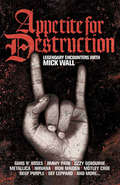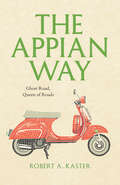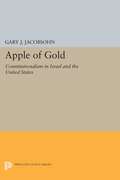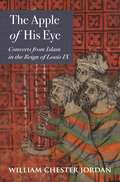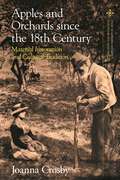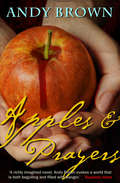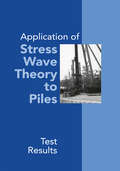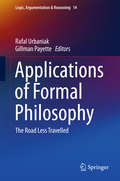- Table View
- List View
Appetite for Destruction: The Mick Wall Interviews
by Mick WallWhether it's hanging around with Marillion's Fish in Berlin, seeing Whitesnake fail to ignite 1985's Rock in Rio, talking through old times with Jimmy Page in his Berkshire pile or following Ozzy Osbourne to Moscow, there isn't a rock luminary that Wall hasn't cross-examined or kept the flame burning with at some point over the last thirty years. Here, amongst several pieces, he catches Lars Ullrich just on the cusp of world domination; has dinner with Ritchie Blackmore on the eve of a Deep Purple comeback; and is up all night in LA with W. Axl Rose.APPETITE FOR DESTRUCTION gathers together Wall's journalism for Kerrang!, for whom he was the star writer in their eighties heyday. It also features brand-new introductions to all the pieces, written with maybe less hair but also the benefit of twenty years' hindsight.
An Appetite for Murder: A Frances Doughty Mystery 4 (A\frances Doughty Mystery Ser. #4)
by Linda StratmannThe sudden death of overweight 49-year-old Thomas Whibley sparks off an acrimonious furore in Bayswater, and sparks fly between rival diet doctors, vegetarians and the extremist Pure Food Society. Young sleuth Frances Doughty is engaged to discover the author of anonymous libels, when a former colleague of Whibley’s, Hubert Sweetman, who has served fourteen years in prison for a violent robbery he claims he did not commit, asks her to trace his estranged family. Before she can start, however, the police arrive and arrest her client for the murder of his wife. There will be more murders and a vicious attack on Frances before she finally resolves a number of knotty questions. Is Hubert Sweetman really innocent? Where are his missing children? And who wielded the poisoned pen? The fourth book in the popular Frances Doughty Mystery series.
An Appetite for Violets: A Novel
by Martine BaileyThat's how it is for us servants. No one pays you much heed; mostly you're invisible as furniture. Yet you overhear a conversation here, and add a little gossip there. A writing desk lies open and you cannot help but read a paper. Then you find something, something you should not have found.Irrepressible Biddy Leigh, under-cook at the foreboding Mawton Hall, only wants to marry her childhood sweetheart and set up her own tavern. But when her elderly master marries the young Lady Carinna, Biddy is unwittingly swept up in a world of scheming, secrets and lies.Forced to accompany her new mistress to Italy, Biddy takes with her an old household book of recipes, The Cook's Jewel, in which she records her observations. When she finds herself embroiled in a murderous conspiracy, Biddy realises that the secrets she holds could be the key to her survival - or her downfall . . .
The Appian Way: Ghost Road, Queen of Roads (Culture Trails: Adventures in Travel)
by Robert A. KasterThe Roman poet Statius called the via Appia “the Queen of Roads,” and for nearly a thousand years that description held true, as countless travelers trod its path from the center of Rome to the heel of Italy. Today, the road is all but gone, destroyed by time, neglect, and the incursions of modernity; to travel the Appian Way today is to be a seeker, and to walk in the footsteps of ghosts. Our guide to those ghosts—and the layers of history they represent—is Robert A. Kaster. In The Appian Way, he brings a lifetime of studying Roman literature and history to his adventures along the ancient highway. A footsore Roman soldier pushing the imperial power south; craftsmen and farmers bringing their goods to the towns that lined the road; pious pilgrims headed to Jerusalem, using stage-by-stage directions we can still follow—all come to life once more as Kaster walks (and drives—and suffers car trouble) on what’s left of the Appian Way. Other voices help him tell the story: Cicero, Goethe, Hawthorne, Dickens, James, and even Monty Python offer commentary, insight, and curmudgeonly grumbles, their voices blending like the ages of the road to create a telescopic, perhaps kaleidoscopic, view of present and past. To stand on the remnants of the Via Appia today is to stand in the pathway of history. With The Appian Way, Kaster invites us to close our eyes and walk with him back in time, to the campaigns of Garibaldi, the revolt of Spartacus, and the glory days of Imperial Rome. No traveler will want to miss this fascinating journey.
The Appian Way: Ghost Road, Queen of Roads (Culture Trails: Adventures in Travel)
by Robert A. KasterThe Roman poet Statius called the via Appia “the Queen of Roads,” and for nearly a thousand years that description held true, as countless travelers trod its path from the center of Rome to the heel of Italy. Today, the road is all but gone, destroyed by time, neglect, and the incursions of modernity; to travel the Appian Way today is to be a seeker, and to walk in the footsteps of ghosts. Our guide to those ghosts—and the layers of history they represent—is Robert A. Kaster. In The Appian Way, he brings a lifetime of studying Roman literature and history to his adventures along the ancient highway. A footsore Roman soldier pushing the imperial power south; craftsmen and farmers bringing their goods to the towns that lined the road; pious pilgrims headed to Jerusalem, using stage-by-stage directions we can still follow—all come to life once more as Kaster walks (and drives—and suffers car trouble) on what’s left of the Appian Way. Other voices help him tell the story: Cicero, Goethe, Hawthorne, Dickens, James, and even Monty Python offer commentary, insight, and curmudgeonly grumbles, their voices blending like the ages of the road to create a telescopic, perhaps kaleidoscopic, view of present and past. To stand on the remnants of the Via Appia today is to stand in the pathway of history. With The Appian Way, Kaster invites us to close our eyes and walk with him back in time, to the campaigns of Garibaldi, the revolt of Spartacus, and the glory days of Imperial Rome. No traveler will want to miss this fascinating journey.
The Appian Way: Ghost Road, Queen of Roads (Culture Trails: Adventures in Travel)
by Robert A. KasterThe Roman poet Statius called the via Appia “the Queen of Roads,” and for nearly a thousand years that description held true, as countless travelers trod its path from the center of Rome to the heel of Italy. Today, the road is all but gone, destroyed by time, neglect, and the incursions of modernity; to travel the Appian Way today is to be a seeker, and to walk in the footsteps of ghosts. Our guide to those ghosts—and the layers of history they represent—is Robert A. Kaster. In The Appian Way, he brings a lifetime of studying Roman literature and history to his adventures along the ancient highway. A footsore Roman soldier pushing the imperial power south; craftsmen and farmers bringing their goods to the towns that lined the road; pious pilgrims headed to Jerusalem, using stage-by-stage directions we can still follow—all come to life once more as Kaster walks (and drives—and suffers car trouble) on what’s left of the Appian Way. Other voices help him tell the story: Cicero, Goethe, Hawthorne, Dickens, James, and even Monty Python offer commentary, insight, and curmudgeonly grumbles, their voices blending like the ages of the road to create a telescopic, perhaps kaleidoscopic, view of present and past. To stand on the remnants of the Via Appia today is to stand in the pathway of history. With The Appian Way, Kaster invites us to close our eyes and walk with him back in time, to the campaigns of Garibaldi, the revolt of Spartacus, and the glory days of Imperial Rome. No traveler will want to miss this fascinating journey.
The Appian Way: Ghost Road, Queen of Roads (Culture Trails: Adventures in Travel)
by Robert A. KasterThe Roman poet Statius called the via Appia “the Queen of Roads,” and for nearly a thousand years that description held true, as countless travelers trod its path from the center of Rome to the heel of Italy. Today, the road is all but gone, destroyed by time, neglect, and the incursions of modernity; to travel the Appian Way today is to be a seeker, and to walk in the footsteps of ghosts. Our guide to those ghosts—and the layers of history they represent—is Robert A. Kaster. In The Appian Way, he brings a lifetime of studying Roman literature and history to his adventures along the ancient highway. A footsore Roman soldier pushing the imperial power south; craftsmen and farmers bringing their goods to the towns that lined the road; pious pilgrims headed to Jerusalem, using stage-by-stage directions we can still follow—all come to life once more as Kaster walks (and drives—and suffers car trouble) on what’s left of the Appian Way. Other voices help him tell the story: Cicero, Goethe, Hawthorne, Dickens, James, and even Monty Python offer commentary, insight, and curmudgeonly grumbles, their voices blending like the ages of the road to create a telescopic, perhaps kaleidoscopic, view of present and past. To stand on the remnants of the Via Appia today is to stand in the pathway of history. With The Appian Way, Kaster invites us to close our eyes and walk with him back in time, to the campaigns of Garibaldi, the revolt of Spartacus, and the glory days of Imperial Rome. No traveler will want to miss this fascinating journey.
The Appian Way: Ghost Road, Queen of Roads (Culture Trails: Adventures in Travel)
by Robert A. KasterThe Roman poet Statius called the via Appia “the Queen of Roads,” and for nearly a thousand years that description held true, as countless travelers trod its path from the center of Rome to the heel of Italy. Today, the road is all but gone, destroyed by time, neglect, and the incursions of modernity; to travel the Appian Way today is to be a seeker, and to walk in the footsteps of ghosts. Our guide to those ghosts—and the layers of history they represent—is Robert A. Kaster. In The Appian Way, he brings a lifetime of studying Roman literature and history to his adventures along the ancient highway. A footsore Roman soldier pushing the imperial power south; craftsmen and farmers bringing their goods to the towns that lined the road; pious pilgrims headed to Jerusalem, using stage-by-stage directions we can still follow—all come to life once more as Kaster walks (and drives—and suffers car trouble) on what’s left of the Appian Way. Other voices help him tell the story: Cicero, Goethe, Hawthorne, Dickens, James, and even Monty Python offer commentary, insight, and curmudgeonly grumbles, their voices blending like the ages of the road to create a telescopic, perhaps kaleidoscopic, view of present and past. To stand on the remnants of the Via Appia today is to stand in the pathway of history. With The Appian Way, Kaster invites us to close our eyes and walk with him back in time, to the campaigns of Garibaldi, the revolt of Spartacus, and the glory days of Imperial Rome. No traveler will want to miss this fascinating journey.
The Appian Way: Ghost Road, Queen of Roads (Culture Trails: Adventures in Travel)
by Robert A. KasterThe Roman poet Statius called the via Appia “the Queen of Roads,” and for nearly a thousand years that description held true, as countless travelers trod its path from the center of Rome to the heel of Italy. Today, the road is all but gone, destroyed by time, neglect, and the incursions of modernity; to travel the Appian Way today is to be a seeker, and to walk in the footsteps of ghosts. Our guide to those ghosts—and the layers of history they represent—is Robert A. Kaster. In The Appian Way, he brings a lifetime of studying Roman literature and history to his adventures along the ancient highway. A footsore Roman soldier pushing the imperial power south; craftsmen and farmers bringing their goods to the towns that lined the road; pious pilgrims headed to Jerusalem, using stage-by-stage directions we can still follow—all come to life once more as Kaster walks (and drives—and suffers car trouble) on what’s left of the Appian Way. Other voices help him tell the story: Cicero, Goethe, Hawthorne, Dickens, James, and even Monty Python offer commentary, insight, and curmudgeonly grumbles, their voices blending like the ages of the road to create a telescopic, perhaps kaleidoscopic, view of present and past. To stand on the remnants of the Via Appia today is to stand in the pathway of history. With The Appian Way, Kaster invites us to close our eyes and walk with him back in time, to the campaigns of Garibaldi, the revolt of Spartacus, and the glory days of Imperial Rome. No traveler will want to miss this fascinating journey.
The Appian Way: Ghost Road, Queen of Roads (Culture Trails: Adventures in Travel)
by Robert A. KasterThe Roman poet Statius called the via Appia “the Queen of Roads,” and for nearly a thousand years that description held true, as countless travelers trod its path from the center of Rome to the heel of Italy. Today, the road is all but gone, destroyed by time, neglect, and the incursions of modernity; to travel the Appian Way today is to be a seeker, and to walk in the footsteps of ghosts. Our guide to those ghosts—and the layers of history they represent—is Robert A. Kaster. In The Appian Way, he brings a lifetime of studying Roman literature and history to his adventures along the ancient highway. A footsore Roman soldier pushing the imperial power south; craftsmen and farmers bringing their goods to the towns that lined the road; pious pilgrims headed to Jerusalem, using stage-by-stage directions we can still follow—all come to life once more as Kaster walks (and drives—and suffers car trouble) on what’s left of the Appian Way. Other voices help him tell the story: Cicero, Goethe, Hawthorne, Dickens, James, and even Monty Python offer commentary, insight, and curmudgeonly grumbles, their voices blending like the ages of the road to create a telescopic, perhaps kaleidoscopic, view of present and past. To stand on the remnants of the Via Appia today is to stand in the pathway of history. With The Appian Way, Kaster invites us to close our eyes and walk with him back in time, to the campaigns of Garibaldi, the revolt of Spartacus, and the glory days of Imperial Rome. No traveler will want to miss this fascinating journey.
The Appin Murder: The Killing That Shook a Nation
by James HunterOn a hillside near Ballachulish in the Scottish Highlands in May 1752 a rider is assassinated by a gunman. The murdered man is Colin Campbell, a government agent travelling to nearby Duror where he’s evicting farm tenants to make way for his relatives. Campbell’s killer evades capture, but Britain’s rulers insist this challenge to their authority must result in a hanging. The sacrificial victim is James Stewart, who is organising resistance to Campbell’s takeover of lands long held by his clan, the Appin Stewarts.James is a veteran of the Highland uprising crushed in April 1746 at Culloden. In Duror he sees homes torched by troops using terror tactics against rebel Highlanders. The same brutal response to dissent means that James’s corpse will for years hang from a towering gibbet and leave a community utterly ravaged.Introducing this new and edition of his account of what came to be called the Appin Murder, historian James Hunter tells how his own Duror upbringing introduced him to the tragic story of James Stewart.
Applaus der Robbe: Arbeit und Vergnügen im Zoo, 1850-1970 (Histoire #173)
by Wiebke ReinertDer Zoo ist vor allem als Bildungs- und Erholungsinstitution geläufig - als urbaner Vergnügungsort innerhalb globaler Netzwerke ist er bisher nicht betrachtet worden. Wiebke Reinert untersucht in ihrer Studie am Beispiel von Seelöwen und deren Tierpfleger:innen das besondere Verhältnis von Arbeit und Vergnügen im Zoo: auf der einen Seite die praktische ›Arbeit am Tier‹, die ebenso Fürsorge wie gewaltsame Kontrolle bedeutete, auf der anderen Seite das populäre Vergnügen, die editorische Arbeit, die Zootiere zu Unterhaltungstieren in Gehegen machte. Die Betrachtung der konkreten Tier-Mensch-Verhältnisse eröffnet somit eine ›andere‹ Geschichte des modernen Zoos.
The Apple II Age: How the Computer Became Personal
by Laine NooneyAn engrossing origin story for the personal computer—showing how the Apple II’s software helped a machine transcend from hobbyists’ plaything to essential home appliance. Skip the iPhone, the iPod, and the Macintosh. If you want to understand how Apple Inc. became an industry behemoth, look no further than the 1977 Apple II. Designed by the brilliant engineer Steve Wozniak and hustled into the marketplace by his Apple cofounder Steve Jobs, the Apple II became one of the most prominent personal computers of this dawning industry. The Apple II was a versatile piece of hardware, but its most compelling story isn’t found in the feat of its engineering, the personalities of Apple’s founders, or the way it set the stage for the company’s multibillion-dollar future. Instead, historian Laine Nooney shows, what made the Apple II iconic was its software. In software, we discover the material reasons people bought computers. Not to hack, but to play. Not to code, but to calculate. Not to program, but to print. The story of personal computing in the United States is not about the evolution of hackers—it’s about the rise of everyday users. Recounting a constellation of software creation stories, Nooney offers a new understanding of how the hobbyists’ microcomputers of the 1970s became the personal computer we know today. From iconic software products like VisiCalc and The Print Shop to historic games like Mystery House and Snooper Troops to long-forgotten disk-cracking utilities, The Apple II Age offers an unprecedented look at the people, the industry, and the money that built the microcomputing milieu—and why so much of it converged around the pioneering Apple II.
The Apple II Age: How the Computer Became Personal
by Laine NooneyAn engrossing origin story for the personal computer—showing how the Apple II’s software helped a machine transcend from hobbyists’ plaything to essential home appliance. Skip the iPhone, the iPod, and the Macintosh. If you want to understand how Apple Inc. became an industry behemoth, look no further than the 1977 Apple II. Designed by the brilliant engineer Steve Wozniak and hustled into the marketplace by his Apple cofounder Steve Jobs, the Apple II became one of the most prominent personal computers of this dawning industry. The Apple II was a versatile piece of hardware, but its most compelling story isn’t found in the feat of its engineering, the personalities of Apple’s founders, or the way it set the stage for the company’s multibillion-dollar future. Instead, historian Laine Nooney shows, what made the Apple II iconic was its software. In software, we discover the material reasons people bought computers. Not to hack, but to play. Not to code, but to calculate. Not to program, but to print. The story of personal computing in the United States is not about the evolution of hackers—it’s about the rise of everyday users. Recounting a constellation of software creation stories, Nooney offers a new understanding of how the hobbyists’ microcomputers of the 1970s became the personal computer we know today. From iconic software products like VisiCalc and The Print Shop to historic games like Mystery House and Snooper Troops to long-forgotten disk-cracking utilities, The Apple II Age offers an unprecedented look at the people, the industry, and the money that built the microcomputing milieu—and why so much of it converged around the pioneering Apple II.
Apple Inc. (Corporations That Changed the World)
by Jason D. O'GradyTwo guys named Steve, working in a garage, created a prototype computer designed to be different in a way no one thought possible: It would be easy to use. Those two Steves, one now a billionaire and still at the head of Apple, not only succeeded with that product, but they also broke ground in the business world in ways few thought possible: They proved you could not only have fun at work, but pursuing a capitalist dream could be hip. How did Apple do it? How did it go from making computers that made a difference but not much of a dent in the overall market to creating a device (the iPod) and a music service (iTunes) that has changed the way we buy and experience music? And how did the Macintosh and its successors capture the hearts and minds of computer users so deeply that being a Mac person makes you a member of a special club? That's what this book is all about.As author Jason D. O'Grady shows, Apple is a rare company—one that is not afraid to think about a future that does not exist and turn it into reality. Critics have written Apple off time and again, yet it rises from the ashes to astound the critics and delight its customers. That's not luck or happenstance—it's vision, dedication, and persistence. Besides delighting Apple aficionados, this book will inspire students eager to launch a business career or work in the technology sector. Apple has never been afraid to chart its own path, and readers will learn what makes the company tick.
Apple of Gold: Constitutionalism in Israel and the United States (PDF)
by Gary J. JacobsohnBy comparing the constitutional systems of Israel and the United States, Gary Jacobsohn provides a new view of the essentials of constitutionalism itself--a balanced picture that would have been impossible to achieve by focusing on any one polity. Abraham Lincoln, in likening the Declaration of Independence to the Biblical "apple of gold," and the Constitution to its "picture of silver," illuminated the connections in the United States between political ideas and constitutional government. Jacobsohn applies Lincoln's insight to the Israeli experience to develop a deeper understanding of the relationship between political culture and constitutionalism, and the limits and possibilities for constitutional transplantation.Originally published in 1994.The Princeton Legacy Library uses the latest print-on-demand technology to again make available previously out-of-print books from the distinguished backlist of Princeton University Press. These editions preserve the original texts of these important books while presenting them in durable paperback and hardcover editions. The goal of the Princeton Legacy Library is to vastly increase access to the rich scholarly heritage found in the thousands of books published by Princeton University Press since its founding in 1905.
The Apple of His Eye: Converts from Islam in the Reign of Louis IX (Jews, Christians, And Muslims From The Ancient To The Modern World Ser. #4)
by William Chester JordanThe thirteenth century brought new urgency to Catholic efforts to convert non-Christians, and no Catholic ruler was more dedicated to this undertaking than King Louis IX of France. His military expeditions against Islam are well documented, but there was also a peaceful side to his encounter with the Muslim world, one that has received little attention until now. This splendid book shines new light on the king’s program to induce Muslims—the “apple of his eye”—to voluntarily convert to Christianity and resettle in France. It recovers a forgotten but important episode in the history of the Crusades while providing a rare window into the fraught experiences of the converts themselves.William Chester Jordan transforms our understanding of medieval Christian-Muslim relations by telling the stories of the Muslims who came to France to live as Christians. Under what circumstances did they willingly convert? How successfully did they assimilate into French society? What forms of resistance did they employ? In examining questions like these, Jordan weaves a richly detailed portrait of a dazzling yet violent age whose lessons still resonate today.Until now, scholars have dismissed historical accounts of the king’s peaceful conversion of Muslims as hagiographical and therefore untrustworthy. Jordan takes these narratives seriously—and uncovers archival evidence to back them up. He brings his findings marvelously to life in this succinct and compelling book, setting them in the context of the Seventh Crusade and the universalizing Catholic impulse to convert the world.
The Apple of His Eye: Converts from Islam in the Reign of Louis IX
by William Chester JordanThe thirteenth century brought new urgency to Catholic efforts to convert non-Christians, and no Catholic ruler was more dedicated to this undertaking than King Louis IX of France. His military expeditions against Islam are well documented, but there was also a peaceful side to his encounter with the Muslim world, one that has received little attention until now. This splendid book shines new light on the king’s program to induce Muslims—the “apple of his eye”—to voluntarily convert to Christianity and resettle in France. It recovers a forgotten but important episode in the history of the Crusades while providing a rare window into the fraught experiences of the converts themselves.William Chester Jordan transforms our understanding of medieval Christian-Muslim relations by telling the stories of the Muslims who came to France to live as Christians. Under what circumstances did they willingly convert? How successfully did they assimilate into French society? What forms of resistance did they employ? In examining questions like these, Jordan weaves a richly detailed portrait of a dazzling yet violent age whose lessons still resonate today.Until now, scholars have dismissed historical accounts of the king’s peaceful conversion of Muslims as hagiographical and therefore untrustworthy. Jordan takes these narratives seriously—and uncovers archival evidence to back them up. He brings his findings marvelously to life in this succinct and compelling book, setting them in the context of the Seventh Crusade and the universalizing Catholic impulse to convert the world.
Apples and Orchards since the Eighteenth Century: Material Innovation and Cultural Tradition (Food in Modern History: Traditions and Innovations)
by Joanna CrosbyShowing how the history of the apple goes far beyond the orchard and into the social, cultural and technological developments of Britain and the USA, this book takes an interdisciplinary approach to reveal the importance of the apple as a symbol of both tradition and innovation. From the 18th century in Britain, technology innovation in fruit production and orchard management resulted in new varieties of apples being cultivated and consumed, while the orchard became a representation of stability. In America orchards were contested spaces, as planting seedling apple trees allowed settlers to lay a claim to land. In this book Joanna Crosby explores how apples and orchards have reflected the social, economic and cultural landscape of their times. From the association between English apples and 'English' virtues of plain speaking, hard work and resultant high-quality produce, to practices of wassailing highlighting the effects of urbanisation and the decline of country ways and customs, Apples and Orchards from the Eighteenth Century shows how this everyday fruit provides rich insights into a time of significant social change.
Apples and Orchards since the Eighteenth Century: Material Innovation and Cultural Tradition (Food in Modern History: Traditions and Innovations)
by Joanna CrosbyShowing how the history of the apple goes far beyond the orchard and into the social, cultural and technological developments of Britain and the USA, this book takes an interdisciplinary approach to reveal the importance of the apple as a symbol of both tradition and innovation. From the 18th century in Britain, technology innovation in fruit production and orchard management resulted in new varieties of apples being cultivated and consumed, while the orchard became a representation of stability. In America orchards were contested spaces, as planting seedling apple trees allowed settlers to lay a claim to land. In this book Joanna Crosby explores how apples and orchards have reflected the social, economic and cultural landscape of their times. From the association between English apples and 'English' virtues of plain speaking, hard work and resultant high-quality produce, to practices of wassailing highlighting the effects of urbanisation and the decline of country ways and customs, Apples and Orchards from the Eighteenth Century shows how this everyday fruit provides rich insights into a time of significant social change.
Apples and Prayers
by Andy BrownDescription 'An orchard itself is neither a true field, nor a true wood, but a holy conjoining of the two.'Servant girl Morgan Sweet spends her life in and around the sixteenth-century apple orchards of Buckland in Devon. It is an existence inextricably joined to the land, the animals, fruits and flowers signalling the passing of each season, detailed so lovingly by Morgan in her story. Life for Morgan and her friends is sometimes merry, sometimes brutal, but always dependent on the obligations of the peasant folk, the patronage of their Lord and Ladies, and the sureties of the Latin prayer book used in church where they worship each week. But in 1549 ominous change is coming to Buckland, as the familiar rituals of life start to tear apart in the bloodiest fashion. Morgan finds that not even the ancient ways her people have known and cleaved to can safeguard against revolution and the terrible measures the powerful are willing to take to quash it.Andy Brown's debut novel is fiercely imagined, rich and wise, while Morgan is a moving and ultimately heartbreaking narrator who reminds us, above all, that we must treasure what we value most.Praise for Apples and Prayers 'Playful, vicious and loving, reminiscent of John Clare and H.E. Bates.' Rob Magnuson Smith'A richly-imagined novel. Andy Brown evokes a world that is both beguiling and filled with danger.' Susanna Jones
Application of Stress Wave Theory to Piles: Proceedings of the 14th International Conference on the Application of Stress-Wave Theory to Piles, The Hague, Netherlands, 21-24 September 1992
by Frans B. J. BarendsThis volume presents the Pile Testing Research Project, and covers most of the results. Topics include: general soil conditions of the test site; pile integrity tests; pile driving prediction contest; pile driving demonstration; and vibratory pile driving techniques.
Application of Stress Wave Theory to Piles: Proceedings of the 14th International Conference on the Application of Stress-Wave Theory to Piles, The Hague, Netherlands, 21-24 September 1992
by Frans B.J. BarendsThis volume presents the Pile Testing Research Project, and covers most of the results. Topics include: general soil conditions of the test site; pile integrity tests; pile driving prediction contest; pile driving demonstration; and vibratory pile driving techniques.
Applications of Formal Philosophy: The Road Less Travelled (Logic, Argumentation & Reasoning #14)
by Rafał Urbaniak Gillman PayetteThis book features mathematical and formal philosophers’ efforts to understand philosophical questions using mathematical techniques. It offers a collection of works from leading researchers in the area, who discuss some of the most fascinating ways formal methods are now being applied. It covers topics such as: the uses of probable and statistical reasoning, rational choice theory, reasoning in the environmental sciences, reasoning about laws and changes of rules, and reasoning about collective decision procedures as well as about action. Utilizing mathematical techniques has been very fruitful in the traditional domains of formal philosophy – logic, philosophy of mathematics and metaphysics – while formal philosophy is simultaneously branching out into other areas in philosophy and the social sciences. These areas particularly include ethics, political science, and the methodology of the natural and social sciences. Reasoning about legal rules, collective decision-making procedures, and rational choices are of interest to all those engaged in legal theory, political science and economics. Statistical reasoning is also of interest to political scientists and economists.
The Applications of Radar and Other Electronic Systems in the Royal Navy in World War 2
by F. A. KingsleyThis book presents a collection of authoritative accounts of the evolution and application of Royal Naval shipborne radars during World War 2 in the fields of weapon control, weapon direction, action information and fighter direction. Accounts are also presented of the successful pioneering activities at the Admiralty Signal Establishment in the fields of counter-measures against various enemy electronic systems in active operations, and also of high-frequency direction-finding, ashore and afloat, which, in conjunction with radar, contributed substantially to winning the Battle of the Atlantic.
